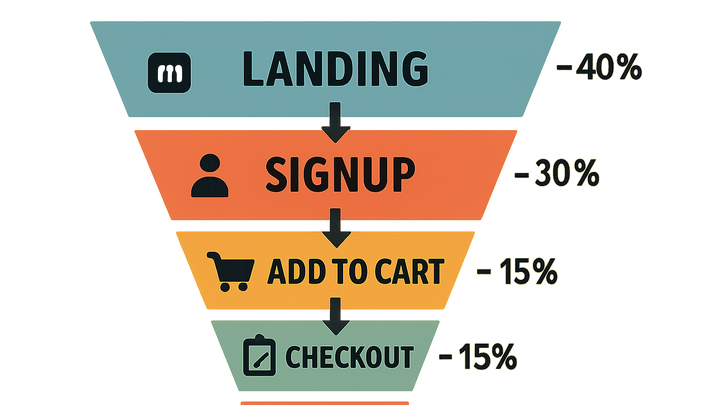Published on 2025-06-29T19:15:01Z
What Is Funnel Analysis? Examples of Funnel Analysis
Funnel analysis is a structured analytic method used in CRO, UX, and SEO to track how users progress through a series of steps on your website, such as landing on a page, signing up for a newsletter, adding a product to the cart, and completing a purchase. By visualizing each stage as a “funnel,” teams can pinpoint where users drop off, uncover friction points, and prioritize improvements that boost conversions and lead generation. Tools like Prevue.me, Google Analytics, Hotjar, and Mixpanel enable marketers and designers to collect both quantitative and qualitative data, from numeric conversion rates to session replays and heatmaps. Funnel analysis not only guides A/B testing and usability refinements but also aligns business goals—like SEO performance and accessibility compliance—with tangible user behavior insights. Regularly monitoring and iterating on your funnels ensures continuous optimization and helps maintain a competitive edge in today’s digital landscape.
Funnel analysis
Track and optimize user progression through website stages to identify drop-offs and boost conversions.
Why Funnel Analysis Matters
Funnel analysis uncovers the stages where users abandon the path, enabling targeted improvements in UX, CRO, and SEO to maximize conversions.
-
Identify drop-off points
Funnel analysis reveals where users exit the conversion path, highlighting friction points.
- Unclear ctas:
When call-to-action buttons aren’t visible or compelling, users are less likely to proceed.
- Slow load times:
Pages that load slowly can frustrate users and lead them to abandon the process.
- Unclear ctas:
-
Optimize user experience
By understanding user flow and pain points, you can refine page layouts, content hierarchy, and navigation to create a seamless journey.
- Navigation flow:
Analyzing how users move between pages reveals if menus and links guide them effectively.
- Content relevance:
Tracking engagement with each step shows whether messaging and offers resonate with your audience.
- Navigation flow:
-
Boost conversion and revenue
Addressing funnel bottlenecks directly increases lead generation, sales, and overall ROI.
- Enhanced lead generation:
Optimizing forms and CTAs can capture more qualified leads.
- Improved seo signals:
Higher engagement and lower bounce rates can improve search rankings.
- Enhanced lead generation:
Key Funnel Metrics to Track
Monitoring specific metrics at each funnel stage helps quantify performance and prioritize optimizations.
-
Conversion rate
The percentage of users who move from one stage to the next or complete a goal.
-
Drop-off rate
The percentage of users who abandon the funnel at a given step.
-
Average time to conversion
The mean time users take to progress through the funnel or complete a target action.
Tools for Funnel Analysis
Various SaaS platforms offer funnel reporting and qualitative insights to help teams understand and optimize conversion paths.
-
Prevue.me
Offers actionable critiques across CRO, UX, SEO, and accessibility to improve each funnel stage and maximize lead generation.
- Actionable critiques:
Provides step-by-step recommendations to reduce drop-offs.
- Lead generation focus:
Suggests optimizations for forms, CTAs, and landing pages.
- Actionable critiques:
-
Google analytics
Free and widely used, GA lets you set up Goal Funnels and view Behavior Flow reports to visualize user paths.
- Goal funnels:
Custom multi-step goal setup to measure completion rates.
- Behavior flow:
Displays how users traverse your site across pages and events.
- Goal funnels:
-
Hotjar
Delivers heatmaps and session recordings to see exactly how real users interact with funnel pages.
- Heatmaps:
Visual maps of clicks, taps, and scrolls to identify engagement patterns.
- Session replays:
Watch individual user sessions to uncover usability issues.
- Heatmaps:
-
Mixpanel
Advanced event-based analytics with cohort comparisons and real-time funnel tracking.
- Cohort analysis:
Compare funnel performance across user segments.
- Real-time funnels:
View funnel metrics that update as events occur.
- Cohort analysis:
Best Practices for Effective Funnel Analysis
Follow these guidelines to ensure your funnel analysis is accurate, comprehensive, and leads to actionable insights.
-
Define clear funnel steps
Map each funnel stage to a distinct user action or event to maintain clarity and consistency.
-
Use consistent naming
Standardize event and goal labels across teams and tools to avoid confusion.
-
Combine quantitative and qualitative data
Pair numeric metrics with user feedback, surveys, and session replays for deeper context.
-
Iterate and test
A/B test changes and regularly review funnel performance to drive continuous improvement.
